 |
 |
 |
| |
Subjective and Objective Fatigue Greater in Older Group With vs Without HIV
|
| |
| |
Download the PDF here
Download the PDF here
From Jules: see previously published study on Fatigue & HIV below following this Aging Workshop study report - suggesting that fatigue is in part caused by psychologic circumstances like depression & stress so that limiting or eliminating stress & depression can improve fatigue ".....the strongest and most uniform associations were observed between fatigue and psychosocial factors such as depression and anxiety ......The largest effect sizes were observed for depression and anxiety, with a somewhat smaller effect size for PTSD and stressful life events.....Each additional lifetime traumatic experience was associated with a 0.068-point higher fatigue score (Model 1c).....Because of its unrelenting nature, it is critical that interventions be developed to lessen fatigue and its debilitating effects on HIV-infected individuals.....This study was designed to provide a prospective, longitudinal description of the natural course of fatigue in HIV-infected persons. Our sample of 128 people was typical of those with HIV infection in the southeastern U.S.: the majority of subjects were middle-aged, male, poor, unemployed African Americans. That most were African American somewhat limits the generalizability of our findings, but that is who is infected in the Deep South. We were interested in determining the chronicity of fatigue, and whether or not it would remit spontaneously over the course of the study. The participants who were the most fatigued at study entry were still the most fatigued at the end of data collection three years later. Also of note is that fatigue does not appear to remit spontaneously, which lends to the urgency to develop interventions for those who are most fatigued."
---------------------------
Subjective and Objective Fatigue Greater in Older Group With vs Without HIV

8th International Workshop on HIV and Aging, October 2-3, 2017, New York
Mark Mascolini
Fatigue objectively and subjectively measured by standard instruments proved significantly greater in 50-and-older people with HIV than in an HIV-negative comparison group [1]. Findings reported represent baseline data in a trial to determine whether an exercise program relieves fatigue in older HIV-positive and negative adults.
The analysis involved 36 people with HIV and 38 similarly aged HIV-negative people enrolled in a trial conducted by researchers from the University of Colorado and the Colorado School of Public Health. HIV-positive people took antiretroviral therapy for at least 2 years, had a viral load below 200 copies, and had a CD4 count of 200 or higher. Before participants began the trial exercise regimen, they provided a subjective fatigue assessment by answering the Short-Form 36 (SF-36) vitality subscore and two fatigue questions on the Centers for Epidemiological Studies and Depression (CES-D) survey. The two objective measures of fatigue were maximum oxygen consumption (VO2max) during a graded treadmill test and 400-meter walk time.
The HIV group did not differ significantly from the HIV-negative group in average age (57.3 and 59.0) or proportion of men (86% and 95%). The HIV-positive and negative groups differed nonsignificantly in proportion of whites (64% and 82%) and blacks (28% and 11%) (P = 0.183). People with HIV had a significantly lower average body mass index (27.5 versus 29.8 kg/m(2), P = 0.039), a significantly lower proportion employed full time (14% versus 66%), a significantly higher proportion unemployed (19% versus 3%), and significantly higher proportions of current cigarette smokers (39% versus 13%, P = 0.0215) and marijuana users (53% versus 14%, P = 0.0004).
The HIV group averaged a significantly lower SF-36 vitality score than HIV-negative controls (48.1 versus 53.6, P = 0.01) and a slightly lower CES-D fatigue score (3.1 versus 3.2, P = 0.75). People with HIV walked 400 meters significantly more slowly (254.6 versus 229.1 seconds, P = 0.004) and had a nonsignificantly lower VO2max (24.7 versus 27.4 mL/kg/min, P = 0.08).
In the combined HIV-positive and negative groups, subjective and objective fatigue measures correlated very weakly and nonsignificantly. The two subjective fatigue measures did correlate significantly (r = 0.31, P = 0.007), and the two objective measures correlated even more strongly (r = -0.46, P < 0.0001).
The researchers believe the lower levels of perceived and physiological fatigue in the HIV group suggest HIV may be independently associated with fatigue in older people. When the exercise portion of the trial concludes in 2017, the investigators will analyze the impact of a supervised exercise program on fatigue in the two study groups.
Reference
1. DeLayna Goulding D, Gross L, MaWhinney S, Jankowski C, Erlandson K. HIV serostatus is associated with greater baseline subjective and objective fatigue among older adults. 8th International Workshop on HIV and Aging. October 2-3, 2017. New York. Abstract 43.
-------------------------------------
HIV Serostatus is Associated with Greater Baseline Subjective and Objective Fatigue among Older Adults
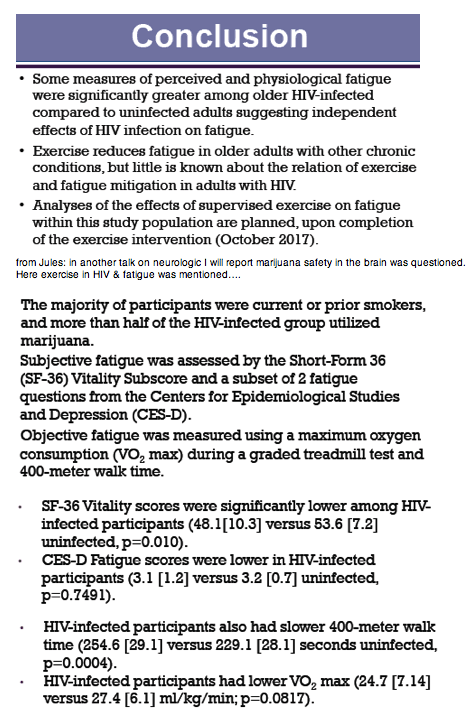
HIV Serostatus is Associated with Greater Baseline Subjective and Objective
Fatigue among Older Adults
DeLayna Goulding1, Lilyana Gross1, Samantha MaWhinney1 , Catherine M Jankowski2, Kristine M Erlandson3
Colorado School of Public Health1, University of Colorado School of Nursing2, University of Colorado School of Medicine3
Study Supported by NIH/NCATS Colorado CTSA Grant Number UL1 TR001082 and NIA K23 (AG050260)
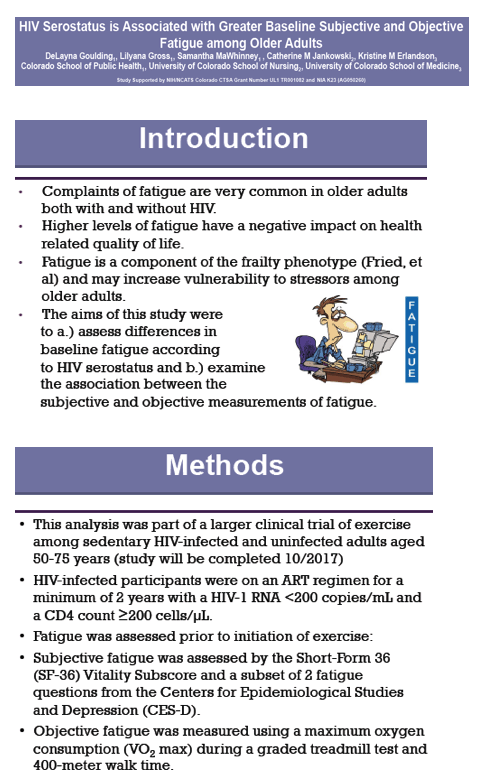
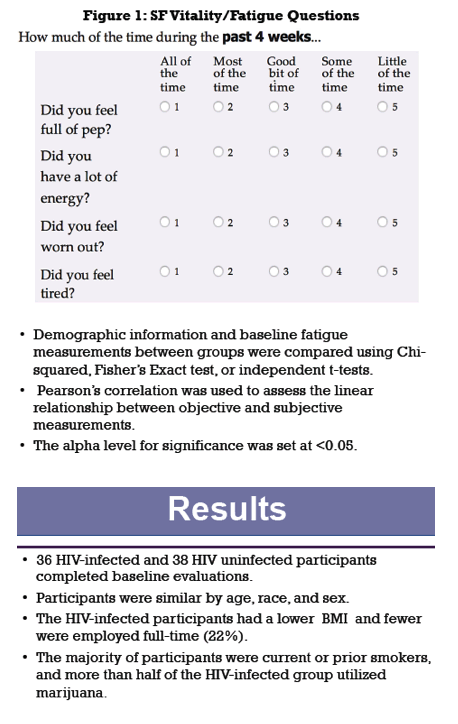
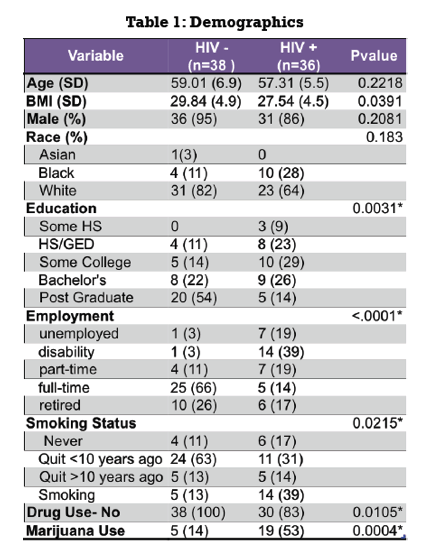

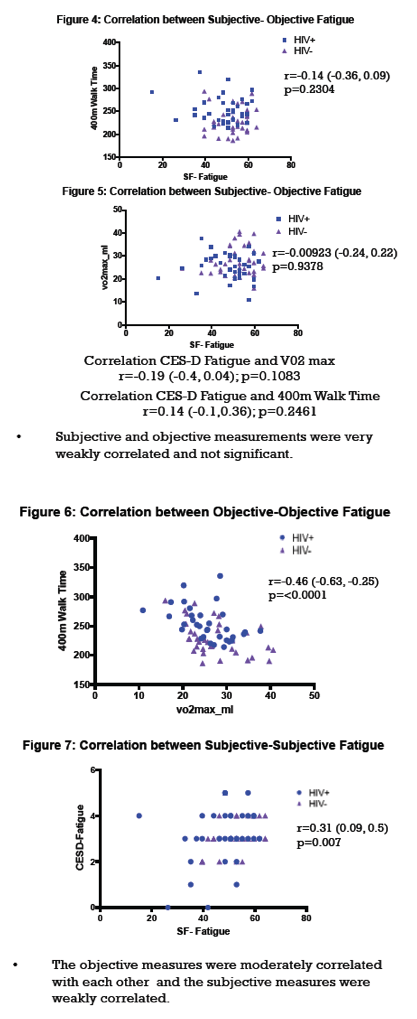

-------------------------------------
see previously published study on Fatigue & HIV below - ".....the strongest and most uniform associations were observed between fatigue and psychosocial factors such as depression and anxiety......The largest effect sizes were observed for depression and anxiety, with a somewhat smaller effect size for PTSD and stressful life events.....Each additional lifetime traumatic experience was associated with a 0.068-point higher fatigue score (Model 1c).....Because of its unrelenting nature, it is critical that interventions be developed to lessen fatigue and its debilitating effects on HIV-infected individuals.....This study was designed to provide a prospective, longitudinal description of the natural course of fatigue in HIV-infected persons. Our sample of 128 people was typical of those with HIV infection in the southeastern U.S.: the majority of subjects were middle-aged, male, poor, unemployed African Americans. That most were African American somewhat limits the generalizability of our findings, but that is who is infected in the Deep South. We were interested in determining the chronicity of fatigue, and whether or not it would remit spontaneously over the course of the study. The participants who were the most fatigued at study entry were still the most fatigued at the end of data collection three years later. Also of note is that fatigue does not appear to remit spontaneously, which lends to the urgency to develop interventions for those who are most fatigued"......see Fatigue in Aging publication below: "fatigue may well resemble the frailty syndrome (i.e., the condition of extreme vulnerability characterizing the older person with limited physiological reserves), and well serve as a potential marker of biological aging.....The identification of fatigue in the older person may potentially serve as an entry criterion for a comprehensive geriatric assessment (GCA), an integrated process of diagnosis, assessment and management.....For example, when fatigue prompts to a hospital admission, the search for a specific diagnosis and treatment of a single cause (e.g., infectious disease, cancer) might be insufficient if not nested in a more comprehensive approach aimed at uncovering all the other
possible determinants of it (e.g., affective disorders, sleep disorders, social issues). Such multidimensional process will lead to a better framing of the health status of the individual, potentially indicate complementary targets of intervention, and generate a more robust structure on which follow the patient over time."
---------------------------
Fatigue in HIV-Infected People: A Three-Year Observational Study.

Fatigue in HIV-Infected People:A Three-Year Observational Study. Journal of Pain and Symptom Management. 2015;50(1):69-79. doi:10.1016/j.jpainsymman.2015.02.006
http://europepmc.org/articles/PMC4492863;jsessionid=61FC28CEAA4D2D0E7BCB8F17345A5308
Abstract
Context
HIV-related fatigue remains the most frequent complaint of seropositive patients.
Objectives
To describe the natural course of fatigue in HIV infection, in a sample (n=128) followed for a three-year period.
Methods
A longitudinal prospective design was used to determine what factors influenced changes in fatigue intensity and fatigue-related impairment of functioning in a community-dwelling sample of HIV-infected individuals. Participants were followed every six months for a three-year period. At each study visit, we collected data on a large number of physiological and psychosocial markers that have been shown to be related to fatigue in HIV-infected people. At three-month intervals between study visits, we collected data on fatigue via mailed questionnaires.
Results
Fatigue in HIV infection is largely a result of stressful life events, and is closely tied to the anxiety and depression that accompany such events. Fatigue did not remit spontaneously over the course of the study, indicating the need for interventions to ameliorate this debilitating symptom.
Conclusion
Intervening to help people who are suffering from HIV-related fatigue to deal with stressful life events may help to ameliorate this debilitating symptom.
Keywords: HIV, fatigue, physiological factors, psychosocial factors
Introduction
"Fatigue does not kill but it is common, disabling, and is regarded as a serious symptom by our patients, who may be victims of a variant of Tudor Hart's inverse care law - an inverse interest law - that the commoner a condition, the less the professional interest."1
Fatigue continues to be a troubling symptom for many with HIV infection,2 with an estimated prevalence of 33-88%.3Research conducted in this area has been problematic: we have detailed in other papers a lack of consistent measurement; a lack of research focus on fatigue as a primary outcome of interest; a lack of longitudinal studies; and a failure to include multiple potential predictors of fatigue in data collection.4-6 We have published several reports of our findings,5,7-13 and there have been a number of other studies examining physiological and/or psychosocial factors related to fatigue in HIV infection; these are described below.
Since Jong et al. completed a comprehensive review of the literature in this area in 2010,3 this review is focused on research conducted since that time. In their review, they found that the strongest predictors of fatigue among sociodemographic variables were unemployment and inadequate income. With regard to HIV-associated factors, combined antiretroviral therapy (ART) was the strongest predictor of fatigue. Interestingly, laboratory values were not predictive of fatigue. The strongest predictors were psychological factors such as depression and anxiety. They found that therapeutic interventions included testosterone, psychostimulants, dehydroepiandosterone (DHEA), fluoxetine, and cognitive behavioral or relaxation therapy.3 These authors recommended the use of the HIV-Related Fatigue Scale, developed by the first author and used in the study reported herein.
Research published since the Jong et al. review3 has extended our understanding of HIV-related fatigue. With regard to ART and illness-related variables, a recent meta-analysis found that fatigue still interferes with antiretroviral adherence;14 however, fatigue was also among several factors that predicted virologic failure independent of adherence measures.15 Fatigue was reported as the most frequent side effect of antiretroviral medications (71% of 953 participants), and was associated with worse health status, decreased work productivity, and/or increased health care resource use.16
Sleep disturbances in HIV-infected patients are understood now in greater detail, especially their relationship to psychological states. Lack of energy, which is closely related to fatigue, is associated with sleep disturbance, anxiety and depressive symptoms; lack of energy is more strongly related to morning fatigue than to evening fatigue.17
Chinese women with HIV infection reported stress that was causing sleeplessness and fatigue.18 Actigraphy revealed that the women did not have refreshing nocturnal sleep; they reported nightmares, worrying about disclosure of their diagnosis and transmission of the virus.18 Insomnia severity scores were correlated with fatigue and anxiety symptoms in another study; sleep latency on two-week actigraphy was longer for HIV-infected participants, and sleep quality was reduced.19 Trouble sleeping is associated with poor antiretroviral adherence.20HIV-infected participants who report difficulty falling asleep experience greater sleep disturbance and symptom burden, particularly anxiety and morning fatigue.21 Greater insomnia severity is associated with greater fatigue severity, and depression may contribute to both fatigue and insomnia.22 High fatigue in both morning and evening is associated with anxiety, depression, and sleep disturbance.23 Stress causes people living with HIV to become sleepless and fatigued; there were significant levels of sleep disturbance and fatigue, which were a result of the perceived stress of living with HIV infection.24
Of the psychosocial variables that have been correlated with fatigue, depression has been strongly and consistently related to fatigue in a number of studies. Anxiety, traumatic life events, post-traumatic stress disorder (PTSD), a lack of social support, and stressful life events also have been related to fatigue. Spirituality and religiosity predict increased religious coping, which influences social support, which in turn positively influences depression, which affects fatigue, and both depression and fatigue predict self-reported physical function.25Psychological factors such as depression, anger and fatigue contribute to the level of distress experienced with HIV-related symptoms.26 Depression has long been associated with fatigue across illnesses, including HIV infection.27 In the review by Jong and colleagues,3 the strongest and most uniform associations were observed between fatigue and psychosocial factors such as depression and anxiety.
There is less evidence that physiological factors are associated with HIV-related fatigue, but there are some intriguing findings. The biological mechanisms are not well characterized. In an investigation of low-abundance plasma proteins in patients treated with nucleoside reverse transcriptase inhibitors (NRTIs) or those who were treatment naïve, the peptides apolipoprotein A-1, apolipoprotein B, histine-rich glycoprotein, alpha-1 B glycoprotein, and orosomucoid 2 were correlated with severity of fatigue; ApoA1 levels were higher in untreated patients, while ApoB results suggested a positive trend in treated patients.28 A high fatigue pattern was associated with five single nucleotide polymorphisms in a study of plasma cytokines; this strengthens evidence for an association between fatigue and inflammation.29 Fatigue was very common, despite viral suppression and good immune function; in a subgroup of patients, prior d-drug exposure and the presence of clinical lipodystrophy syndrome were associated with fatigue.30 Fatigue severity was correlated strongly with symptomatic orthostatic intolerance. The literature on the relationship of fatigue to CD4 count and HIV viral load remains inconclusive; less fatigue was related to higher CD4 counts and lower HIV viral loads in a recent study.31 Fatigued participants had lower levels of the cellular energy marker total creatine in the basal ganglia; this indicates energy dysmetabolism in this brain region, with striatal-cortical circuitry involvement.27 Voss et al.32 found fatigue-related gene networks in CD(14)+ cells; they identified 32 genes that were predictive of low versus high fatigue, along with mitochondrial inner membrane proteins. Neuropathic-related numbness preceded reports of fatigue, and muscle aches and numbness explained 28% of the random variance in the occurrence of fatigue.33
There have been few intervention studies. In a review of treatment strategies, Jong et al.3 noted that studies on treatment strategies were minor in nature and focused on a select group of patients, most of whom had a major depressive disorder or clinical hypogonadism. Modafinil and armodafinil are the treatments with the most evidence; there have been multiple studies with robust sample sizes conducted by Rabkin and colleagues34-39 and the results have consistently been reported as being effective in treating HIV-related fatigue.
Our work on nighttime sleep quality, daytime sleepiness, stressful life events, and HIV-related fatigue in this sample has been reported elsewhere.10We report here data on the following aim: to examine prospectively the relationships of personal and HIV-related variables and changes in physiological and psychosocial variables to fatigue intensity and fatigue-related impairment of functioning over time in HIV-infected individuals.
Results
Table 1 includes demographic data about the sample. We admitted fatigued (n=111) and non-fatigued (n=17) HIV-infected participants into the study. The majority of subjects were African American (66%), men (66%), unemployed (67%), and on ART (82%). The demographic distribution of the sample closely mirrors the HIV epidemiologic data for the state of North Carolina and the broader Southeast.62 The median age was 44 years. The median number of years of education was 12, and the median monthly income of the sample was $685. The sample predominantly comprised people who had lived with HIV infection for a long time, with a median of 10 years since diagnosis (range, 0-25 years). The mean CD4 count was 517/mm3 (median 457), and 68% of the sample had HIV RNA viral loads <400 copies/mL.
Table 2 shows the unadjusted effects of sociodemographic and clinical characteristics with fatigue intensity and functioning over three years. Fatigue intensity and impairment of functioning tended to be higher among African Americans, among those with fewer years of education, and among those with lower incomes.
Tables 3 and and44 present unadjusted between- and within-person associations of psychosocial and physiological variables with the fatigue measures. Again, estimates for the between-person association reflect the effect of an individual participant's average over time, and the estimates for the within-person association reflect the effect of an individual participant's change over time. Childhood trauma was measured at the baseline visit only because it represents events that occurred in the distant past and does not change over time. For most psychosocial measures, both the between-person (mean) and within-person (deviation) effects were strong and significant increases in psychosocial distress were associated with increases in fatigue. On average, a one SD difference in mean depression score was associated with a 1.52 points higher score on the fatigue-related impairment of functioning scale (between-person effect; P < 0.001). Additionally, a within-person one SD change in their depression score was associated with a 0.66 point SD increase in fatigue-related impairment of functioning (within-person effect; P < 0.001). The largest effect sizes were observed for depression and anxiety, with a somewhat smaller effect size for PTSD and stressful life events. Effect sizes were generally comparable when modeling fatigue intensity (Table 3) compared to fatigue-related impairment of functioning (Table 4). Few physiological variables were related to fatigue intensity or fatigue-related impairment of functioning. Exceptions were between-person associations between testosterone, DHEA, and fatigue intensity; a between-person association between testosterone and fatigue-related impairment of functioning; and a within-person association between serum erythropoietin and fatigue-related impairment of functioning.
Table 5 presents the adjusted effects of clinical and psychosocial variables on fatigue intensity. After controlling for other factors, the between-person term for income was the only sociodemographic or clinical variable that remained significantly associated with fatigue (Model 1b). Each additional lifetime traumatic experience was associated with a 0.068-point higher fatigue score (Model 1c). Consistent with our mediation hypothesis, lifetime trauma had a nearly null association with fatigue intensity after including recent stressful events and social support in the model (Model 2).
In Model 2, each additional SD increase in recent stressful events was associated with a 0.43 point higher fatigue intensity score (between-person association). This association was partially attenuated but remained elevated and significant after adjustment for measures of current mental health (Models 3a-3c), consistent with a hypothesis that current mental health partially mediates the effect of stress on fatigue but that stress retains a direct effect on fatigue independent of current mental health symptoms. The measures of mental health symptomatology were themselves strongly associated with fatigue intensity, with a one-SD increase in PTSD, anxiety, and depression symptoms corresponding to a 0.33, 0.53, and 0.48 point increase in fatigue intensity, respectively (between-person associations). The within-person associations were similar in direction and statistical significance to the between-person associations but smaller in magnitude.
Discussion
This study was designed to provide a prospective, longitudinal description of the natural course of fatigue in HIV-infected persons. Our sample of 128 people was typical of those with HIV infection in the southeastern U.S.: the majority of subjects were middle-aged, male, poor, unemployed African Americans. That most were African American somewhat limits the generalizability of our findings, but that is who is infected in the Deep South. We were interested in determining the chronicity of fatigue, and whether or not it would remit spontaneously over the course of the study. The participants who were the most fatigued at study entry were still the most fatigued at the end of data collection three years later. Also of note is that fatigue does not appear to remit spontaneously, which lends to the urgency to develop interventions for those who are most fatigued.
Over the three years of data collection, fatigue intensity and impairment of functioning tended to be higher among African Americans, among those with fewer years of education, and among those with lower incomes. People with fewer years of education tend to be in blue collar jobs that pay lower wages, and these jobs are often much more physically demanding than the white collar jobs available to those with more education. People with higher incomes often are able to hire people to do the most demanding activities, e.g., yard work, cleaning the house. We do not think that lower income affected access to care in our sample, as all reported having a primary care provider, and there was adequate clinical care for people with HIV infection, including those with limited funds or health insurance, in this particular geographical area.
Few physiological variables were related to fatigue intensity or fatigue-related impairment of functioning. After controlling for other factors, income was the only sociodemographic or clinical variable that remained significantly associated with fatigue. Each additional standard deviation increase in recent stressful events was associated with a 0.43 point higher fatigue intensity score. This association was partially attenuated but remained elevated and significant after adjustment for measures of current mental health (PTSD, anxiety and depression), consistent with our hypothesis that current mental health partially mediates the effect of stress on fatigue but that stress retains a direct effect on fatigue independent of current mental health symptoms. The measures of mental health symptomatology were themselves strongly associated with fatigue intensity, with a one SD increase in PTSD, anxiety, and depression symptoms corresponding to a 0.33, 0.53, and 0.48 point increase in fatigue intensity, respectively. Given the strong relationship between psychosocial factors and fatigue, Jong and colleagues3 recommended research comparing the effects of medication (antidepressants, anxiolytics) and behavioral interventions (cognitive behavioral therapy, relaxation therapy, graded exercise therapy) to direct the best treatment strategy.
Several of our findings are striking; the longer a subject had been HIV-infected, the less fatigue they reported. It is possible that they have learned adaptive coping strategies that have helped them live with HIV as a chronic, manageable illness; it is also possible that they have modified their lives in incremental steps to accommodate fatigue. It is useful to know that physiological variables, including those that are disease markers for HIV infection, are not predictors of fatigue. Our findings suggest that monitoring lab values has little utility in identifying a cause for fatigue. It would still be appropriate to check for anemia and/or hypogonadism, but beyond that, there is no evidence that points to a physiological factor as a predictor of fatigue. Because of its unrelenting nature, it is critical that interventions be developed to lessen fatigue and its debilitating effects on HIV-infected individuals.
-----------------------
Fatigue: Relevance and implications in the aging population
Highlights
⋅ Fatigue is a burdening and common symptom in older adults.
⋅ Fatigue is associated with negative health-related outcomes.
⋅ As a result of abnormal process, fatigue may capture exhaustion of vital reserves.
⋅ A close interaction among pain, depression and fatigue exists.
⋅ Future research on this neglected symptom of fatigue is needed.
Abstract
Frailty has been identified as a promising condition for distinguishing different degrees of vulnerability among older persons. Several operational definitions have proposed fatigue as one of the features characterizing the frailty syndrome. However, such a subjective symptom is still not yet sufficiently explored and understood.
Fatigue is a common and distressing self-reported symptom perceived by the person while performing usual mental and physical activities, highly prevalent in older people, and strongly associated with negative health-related events. The understanding of fatigue is hampered by several issues, including the difficulty at objectively operationalizing, the controversial estimates of its prevalence, and the complex pathophysiological mechanisms underlying its manifestation. Despite such barriers, the study of fatigue is important and might be encouraged. Fatigue may be the marker of the depletion of the body's homeostatic reserves to a threshold leading to its psycho-physical functional impairment, mirroring the concept of frailty. Its subjective and symptomatic nature resembles that of other conditions (e.g., pain, depression), which equally affect the individual's quality of life, expose to negative outcomes, and severely burden healthcare expenditures.
In the present paper, we present an overview of the current knowledge on fatigue in older persons in order to increase awareness about its clinical and research relevance. Future research on this topic should be encouraged and developed because it could potentially lead to novel interventions against this symptom as well as against frailty and age-related conditions.
As mentioned above, the mechanisms underlying the fatigue manifestation are not well understood. Fatigue may be influenced by multiple biological (e.g., changes in skeletal muscle function, cardiovascular impairment, inflammatory mediators, nutritional deficiencies) and psychological (e.g., mood disorders) factors (Avlund, 2010; Beyer et al., 2012; Gonzales et al., 2014; Gonzales et al., 2015). Fatigue may mirror the erosion of the physiological reserves of the body. In fact, fatigue may occur as consequence of an imbalance between the required effort and the capacity of the organism to successfully meet it. It is generated when the required resources are insufficient due to a disproportionate demand for the altered homeostatic mechanisms (Alexander et al., 2010). In this context, fatigue may well resemble the frailty syndrome (i.e., the condition of extreme vulnerability characterizing the older person with limited physiological reserves), and well serve as a potential marker of biological aging.
|
| |
|
 |
 |
|
|